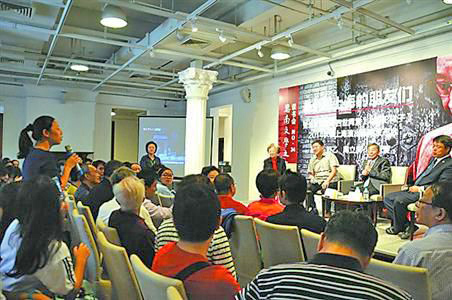Scholars discuss communication and creativity in cities

The picture shows the Sinan Reading Party, which is held in Shanghai every Saturday. The party, where authors and scholars dialogue with readers face to face, is beneficial to fostering urban communication network.
The Communication and China: Fudan Forum 2017, which was held in Shanghai from Dec. 1 to 2, gathered more than 100 scholars to discuss the topic “Global City: Communication and Creativity.”
In an era of mobile networking, cities around the globe are becoming nodes for joining networks of data, material and people. Digital media are penetrating into all areas of daily life in cities, and communication plays a significant role in promoting creativity.
Yin Minghua, secretary of the Party Committee of the Journalism School at Fudan University, said at the forum that creativity is an important theme today. Against the backdrop of technological upgrading within new media and the transformation of the media industry, various new patterns of communication are emerging that utilize advanced technologies. In the ongoing process of urbanization, creativity and city life are becoming increasingly related. A dialogue about new patterns of communication is timely in the context of fostering an innovative spirit in cities.
Huang Dan, director of the Center for Information and Communication Studies at Fudan University, said that urbanization is an important national strategy in China and also a major trend. Based on the country’s unique experience in this respect, Chinese scholars have produced remarkable results in terms of communication studies in cities.
Amid the progress of globalization, urbanization and technologies, Chinese scholars should create their own communication theories and knowledge systems based on domestic practice and experience, and then they should utilize these theories and practices to stimulate creativity among the public. It is of great significance exploring new angles and values of journalism and communication studies in research on cities and new media, and in turn realizing the transformation and innovation of the discipline.
Huang shed light on the disciplinary construction of China’s journalism and communication studies. He said that it is necessary to look back upon the historical premises of establishing the discipline and recall the definition for the name of the discipline. The definition and understanding of the discipline should not stay at the level of a knowledge system. Rather, it should take into consideration the social environment.
Huang said the discipline today should reflect upon practice in the mass media age and then innovate the theoretical paradigm. The discipline should reconsider the relationship between media and people, and pay attention to new communication patterns brought about by new technologies. It should also develop new understanding and assessment for the media industry and then decide the educational objectives in the new media age.
Li Leilei, a professor from the College of Mass Communication at Shenzhen University, held that the main manifestations of a creative global city include the involvement of different social entities in creativity activities as well as the invention and application of media technologies. They also include the intensive, continuous and reflexive interactive relationship between city space and economic transformation, recombination and upgrading.
Han Lixin, dean of the School of Journalism and Communication at Hebei University, provided insights into how to construct city image by visual means. He stated that cities should foster unique styles through distinctive visual presentation models, integrate both traditional media and new media to create an all-dimensional experience, and be people-oriented, meaning the focus should be put on people’s lives.
